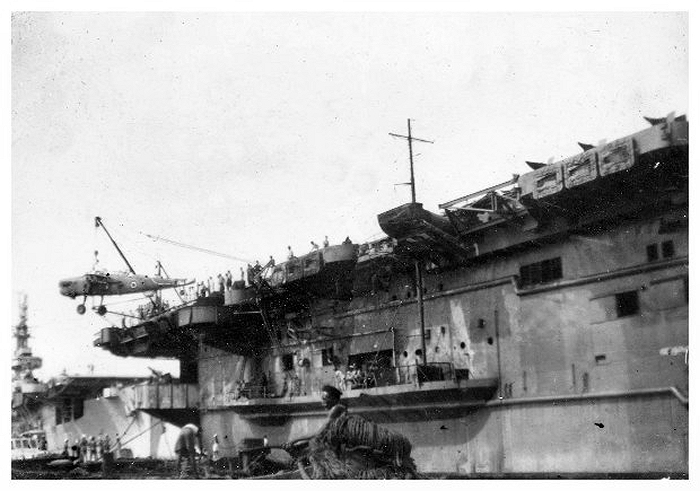A History of HMS QUEEN

|
 |
HMS QUEEN in her trooping role, January 3rd 1946.
Sydney, Australia. Photo: David Weaver |
Laid down 12 March 1943, by the Seattle-Tacoma
shipbuilding Co. Tacoma, Washington as a C3-S-A1 type freighter,
Maritime Commission hull number 260, Seattle-Tacoma hull number 44;
purchased by the US navy to be the USS ST. ANDREWS ACV-49
(changed to CVE -49, July 15th, 1943). She was launched 31 July by her
sponsor Mrs. Robert W. Morse. Whilst still under construction it had
been decided that CVE 49 was to be transferred to the Admiralty on loan
on her completion as an aircraft carrier.
Upon her completion she was delivered to the US Navy
as USS St. Andrews December 7th 1943, and was transferred to the
Royal Navy on that date, commissioned into RN service as HMS
QUEEN (D19) , Captain K.J. D'Arcy RN in command. She was
the sixth ship to bear the name.
After completing sea trials Queen sailed
for Vancouver, British Colombia, entering Burrard Drydock at
Vancouver to begin modification to bring equipment to RN
standards and to outfit her as a strike/CAP carrier. On
completion she sailed for the Panama Canal, stopping over in
Miami for two weeks before sailing on to Norfolk, Virginia. On
May 6th 1944 she embarked the 12 Avenger II aircraft of 855
squadron for passage from Norfolk to the UK. The
squadron was disembarked to RAF Hawkinge on May 31st. HMS Queen
served as an escort for Russia convoys late in the war; took part in
strike on German shipping in Norway 5/1945. Also operated as a
transport carrier.
HMS Queen was assigned pennant number R320
circa 1945 for service in the Pacific, but operated with the British
East Indies Fleet. She was later employed as one of six CVEs specially
converted to the troop ship role post-war, ferrying ex-POWs from Europe
to Australia and Hong Kong.
Her first trooping run was a round trip passage UK to
Fremantle and Sydney with a ship full of New Zealanders and a small
contingent of men form the Royal Australian navy. She broke down shortly
after leaving Colombo on the 16th December 1945 and had to struggle back
into port for repairs; she left again for Fremantle the following day.
|
 |
HMS QUEEN loading Barracuda fuselages in Colombo Harbour
January 1946; HMS PATROLLER is moored behind her. The
aircraft are for dumping at sea. Photo: From the
collection of Leslie Howlett |
On the return leg to the UK she arrived at Colombo
(from Fremantle) on the 25th January 1946 to be loaded with boxed
torpedoes, unwanted aircraft, aircraft engines and other spares for
ditching at sea of the Ceylonese coast. After completing her disposal
activities and a turn around in the UK 'Queen' repeated the voyage to
Australia, arriving in Colombo on the 26th March 1946, sailing on 1st
April, she again took part in the ditching of aircraft at sea on the
return leg.
Returned to US Navy at Norfolk. Virginia and HMS 'Queen'
was decommissioned by the Royal Navy on 31 October 1946. She was
stricken for disposal on 22 Jan 1947, and Sold to the N.V. Stoomv,
Maats, Nederland Co., Amsterdam, Netherlands for merchant service as
'Roebiah' on 29 July 1947. purchased in 1967 by the Philippine
Presidents Line Inc and renamed 'President Marcos'. Later renamed 'Lucky
One' in 1972 for delivery voyage to ship breakers. Scrapped in Taiwan in
1972.

A
fuller account of this ships history will be added at some time in
the future.
Content revised:
31 October 2021
Sources used in compiling this account:
Click here for a list of
Primary sources
Additional sources:
Fold3.com various documents including;
Admiralty War Diaries
Norfolk Navy Yard War Diaries
Mew York Navy Yard War Diaries
Miscellaneous documents
|
Home
page |
go to the top
|
Comments (0)